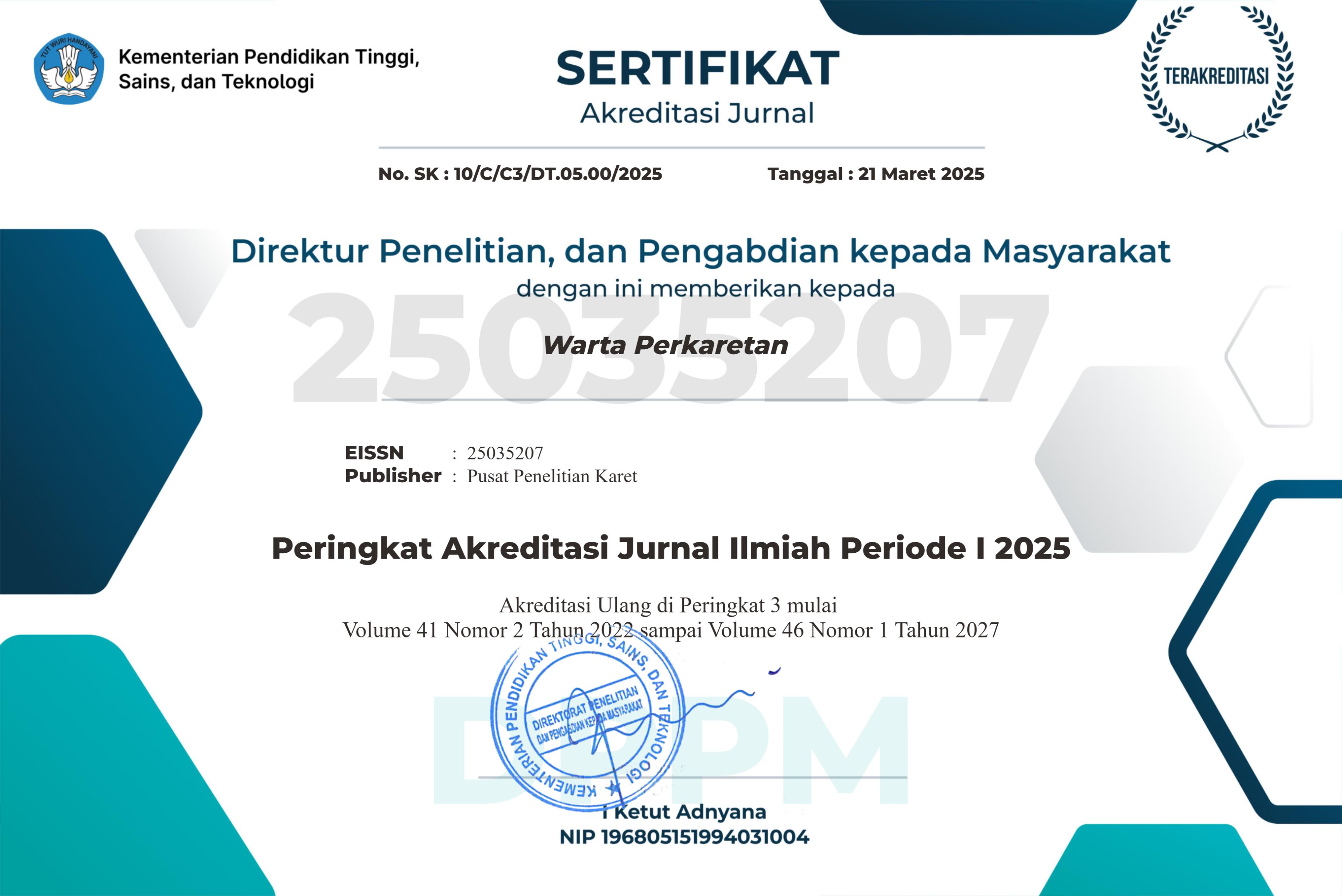INTERAKSI GENOTIPE X MUSIM KARAKTER FISIOLOGI LATEKS DAN DAYA HASIL BEBERAPA GENOTIPE KARET HASIL PERSILANGAN TAHUN 1992
DOI:
https://doi.org/10.22302/ppk.wp.v36i2.388Keywords:
Hevea brasiliensis, genotype, physiology characters, latex yield, sucrose, thiol, inorganic phosphate, dry and wet months.Abstract
Latex physiology characters and yield potential of rubber tree (Hevea brasiliensis) are determined by genetic factor, environments, and genotype x environment interaction. The environmental conditions greatly influence latex physiology characters and latex yield potential are the monthly rainfalls. The objective of the research was to get information about the performance of latex physiology characters and yield potential of some promising rubber genotypes of crossing results in 1992 in dry and wet months period. The experimental design used was randomize completely design (RCD) with two factors and three replications. The first factor was genotypes consisted of 15 genotypes and 2 control clones of PB 260 and RRIC 100. The second factor was season consisted of the wet months period (August - November 2015) and dry months period (January - March 2016) based on classification of Oldeman. The research result showed that the genotype x season interaction effect was significant to sucrose content, inorganic phosphate content, thiol content, latex flow rate, plugging index, yield index, and latex yield potential. Genotype HP 92/542 was a more tolerant to seasonal changes and this genotype had high latex yield and more stable. The genotype can be developed as a new genetic material of superior rubber clone. Genotype HP 92/726 was also tolerant to seasonal changes but the genotype had low latex yield. The genotype HP 92/838 was intolerant to seasonal changes and the genotype had low latex yield and unstable.
References
Ardika, R., A. N. Cahyo dan T. Wijaya. 2011. Dinamika gugur daun dan produksi berbagai klon karet kaitannya dengan kandungan air tanah. J. Penel. Karet, 29(2): 102-109.
Atminingsih. 2015. Respon Fisiologi Lateks dan Histologi Pembuluh Lateks Beberapa Klon terhadap Konsentrasi Stimulan yang Berbeda pada Tanaman Karet (Hevea brasiliensis Muell. Arg.). [tesis]. Medan (ID). Universitas Sumatera Utara.
Atminingsih, J.A. Napitupulu, dan T.H.S. Siregar. 2016. Pengaruh konsentrasi stimulan terhadap fisiologi lateks beberapa klon tanaman karet (Hevea brasiliensis Muell. Arg.). J. Penel. Karet. 35(1): 1-10.
Cahyo A N, Ardika R, Wijaya T. 2011. Konsumsi air dan produksi karet pada berbagai sistem pengaturan jarak tanam dalam kaitannya dengan kandungan air tanah. J. Penel. Karet 29 (2): 110-117.
Duzdemir, O. 2011. Stability analysis for phenological characteristics in chickpea. Afr. J. Agric. Res. 6:1682- 1685.
Gireesh T, Raj S, Kavita KM, Mercykutty VC. 2011. Rubber yield of certain clones of Hevea Brasiliensis and Its relationship with climate variables. J. Nat. Rubb. Res. 24(1): 54 – 60.
Gunasekara HK, De Costas JM, Nugawela A. 2013. Canopy photosynthetic capacity and light response parameters of Hevea Brasiliensis with reference to exploitation. J. Agri. Res. 1(1) : 1- 12.
Jandong, E.A., M.I. Uguru, B.C. Oyiga. 2011. Determination of yield stability of seven soybean (Glycine max) genotypes across diverse soil pH levels using GGE biplot analysis. J. Appl. Biosci. 43:2924-2941.
Junaidi, Sembiring YRV, Siregar THS. 2015. Pengaruh perbedan letak geografi terhadap pola produksi tahunan tanaman karet: pola produksi dan pengaruhnya terhadap pasar dunia. Warta Perkaretan. 34 (2): 127-136.
Kartasapoetra, A.G. 2004. Pengaruh Iklim Terhadap Tanah dan Tanaman. Bumi Aksara Press. Jakarta.
Kuswantoro. 2007. Pemuliaan kacang panjang tahan penyakit mosaik. Malang (ID). UB Pr.
Mirabello MJ, Yavitt JB, Garcia M, Harms KE, Turner BL, and Wright SJ. 2013. Soil phosphorus responses to chronic nutrient fertilisation and seasonal drougth in a humid lowland forest in Panama. J. Soil. Res. 51: 215-221.
Prihastanti, E., S. Tjitrosemito, D. Sopandie, dan I. Qoyim. 2015. Pertumbuhan fineroot kakao (Theobroma cacao)pada cekaman kekeringan selama 13 bulan di kawasan agroforestri dengan pohon pelindung utama gamal (Gliricidia sepium). Pros. Sem. Nas. Biodiv. Indo.1(7): 1683-1688
Purwaningrum Y. 2016. Fisiologi dan Produksi Karet dengan berbagai Sistem Sadap dan Penggunaan Stimulan Gas.[disertasi]. Medan (ID). Universitas Sumatera Utara.
Roux YL, Ehabe E, Beuve JS, Kengafac JN, Keng JN, Ngolemasango F, Gobina S. 2000. Seasonal and clonal variation in latex and raw rubber of Hevea Brasiliensis. J. Rub. Research. 3(3): 142 – 156.
Sari LW, Nugrahaeni N, Kuswanto, Basuki N. 2013. Interaksi genotipe x lingkungan pada galur-galur harapan kedelai (Glycine max L.). J. Prod. Tan. 5(1): 434-441.
Sayurandi. 2016. Dinamika Daya Hasil Lateks Beberapa Genotipe Karet Harapan PP/07/04 Terhadap Perubahan Musim.[Thesis]. Institut Pertanian Bogor. Bogor.
Schartner, J., K.N.A. Gavriljuk., P.M. Weide.,M.G. Muhler and C. Kotting. 2014. Immobilization of proteins in their physiology active state at functionalized thiol monolayers on ATR-Germanium Crystal. Bio Chem. 15(17): 2529-2534.
Sharrifmoghaddassi, M., A.H. Omiditabrizi. 2010. Stability analysis of seven Iranian winter safflower cultivars. World Appl. Sci. J. 8:1366-1369.
Siregar HA, Purba E, Syamsuddin, Poeloengan Z. 1995. Penanggulangan kekeringan pada tanaman kelapa sawit. Warta PPKS. 3(1): 9-14.
Siregar THS. 2014. Pola musiman produksi dan gugur daun pada klon PB 260 dan RRIC 100. J. Penel. Karet. 32(2): 88-97.
Sundari, T., N. Nugrahaeni, dan G.W.A. Susanto.2016. Interaksi Genotipe x Lingkungan dan Stabilitas Hasil Biji Kedelai Toleran Naungan. J. Agron.Indonesia, 44 (1):16-25.
Syukur M, Sujiprihati S, Yunianti R. 2012. Teknik Pemuliaan Tanaman. Jakarta (ID). Penebar Swadaya.
Woelan S, Sayurandi, Pasaribu SA. 2012. Keragaan klon klon IRR seri 300 dan 400 di pengujian plot promosi. Warta Perkaretan 31(1): 1-10
Woelan S, Sayurandi, Pasaribu SA. 2013. Karakter fisiologi, anatomi, pertumbuhan dan hasil lateks klon IRR seri 300. J. Penel. Karet 31(1): 1-12.
Zambrosi FCB, Fernando C, Zambrosi B, Mattos D, Rodrigo, Boaretto M, Quaggio JA, Muraoka T, Syvertsen JP. 2012. Contribution of phosphorus (32P) absorption and remobilization for citrus growth. J. Plant Soil. 255: 353-362.








